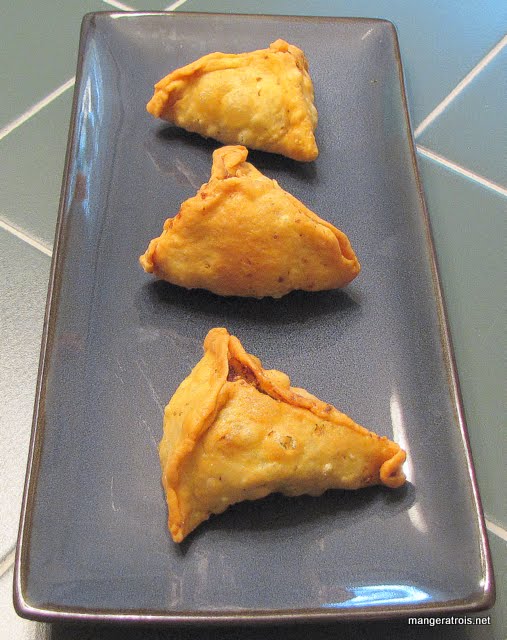Potato Samosas
Ingredients
For the filling
1 1⁄2 pounds potatoes, cubed
2 tablespoons oil
2 teaspoons cumin seeds
2 tablespoons fresh ginger, peeled and minced
1-3 fresh green chile peppers, such as jalapeño, minced
1 1⁄2 tablespoons ground coriander
1⁄2 teaspoon salt, or to taste
1⁄2 teaspoon garam masala
1⁄4 cup fresh cilantro, finely chopped
1 teaspoon mango powder (Optional. I’ve made it many times without, one time with, and it’s amazing regardless.)
1 cup frozen peas
_
For the assembly_
1 1⁄2 cups self-rising flour
3 tablespoons oil
1⁄2 teaspoon ajwain seeds, coarsely ground (Optional. I’ve omitted these due to availability with no problem.)
1⁄2 teaspoon salt, or to taste
1⁄3 cup water, approximately
Extra all purpose flour for dusting
1 1⁄2 to 2 cups peanut oil, for deep-frying
Instructions
1. For samosa filling: Bring a large pot of water to boil and cook the potatoes until tender, about 20 minutes. Heat the oil in a large nonstick wok or saucepan over medium-high heat and add the cumin seeds; they should sizzle upon contact with the hot oil. Mix in the potatoes.
2. Stir about 2 minutes, then add the ginger, green chile peppers, coriander, salt, and garam masala, and stir occasionally until the potatoes are golden, about 10 minutes.
3. Add the cilantro, mango powder and peas and cook another 5 minutes. Remove from heat and let cool before using.
4. For assembly: Place the self-rising flour, oil, ajwain seeds, and salt in a food processor and pulse a few times to mix. With the motor running, pour the water in a slow stream and process until the flour gathers into a semi-firm ball that does not stick to the sides of the work bowl. Remove to a bowl, cover with plastic wrap or a lid, and let rest at least 1 hour and up to 4 hours. (This allows the gluten to develop.) If keeping for a longer period, refrigerate the dough.
5. Lightly oil your clean hands (to prevent the dough from sticking to them), then divide into 12 1 1⁄2-inch balls. Cover with aluminum foil and set aside. Working with each ball separately, flatten it into a disc with your fingertips, coat well with dry flour, the roll with a rolling pin into a 6- to 7-inch circle of uniform 1⁄8-inch thickness. If the dough sticks to the rolling surface, coat once again with flour.
6. Cut the circle in half and brush with water about 1⁄2-inch in, along the straight edge. Pick up the two corners and place one over and around the other along the straight edge, the press along the straight edge to seal, making a cone. Also pinch the point of the cone to seal. (Alternatively you can make the dough circles using a pasta roller on a thick setting. I tried this method and it worked amazingly well.)
7. Hold the cone between your thumb and forefinger, with the pointed side down toward the work surface. Fill the mouth of the cone with 2 to 3 tablespoons of filling. Brush the edges of the mouth of the cone with water and press them together to seal. You should end up with a stuffed triangular pastry. Cover with foil and set aside until ready to fry. Repeat with the other balls of dough.
8. Heat the oil in a wok or skillet over medium-high heat until it reaches 325*F to 350*F on a frying thermometer, or when a small piece of the dough dropped into the hot oil rises to the top after 15 to 20 seconds. Place the samosas in the wok, as many as it can hold at one time without crowding, and fry, turning them a few times with a slotted spatula, until crispy and golden on all sides, 4 to 5 minutes. (If the samosas brown too quickly, it means the heat is too high; lower it.) Transfer to paper towels to drain, then serve.

Comments
This recipe is from 1,000 Indian Recipes by Neelam Batra. I’ve made it numerous times and each time it gets easier. I’m not going to lie and say “this isn’t as hard as it looks” because it is a pretty complicated recipe. However it is well worth the effort. I like to serve these with mango chutney. Yum. The trick of using the pasta roller did make the whole process infinitely faster.
1,000 Indian Recipes